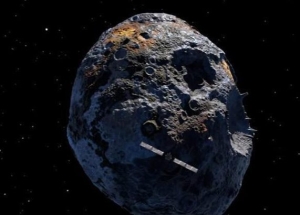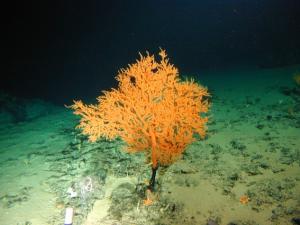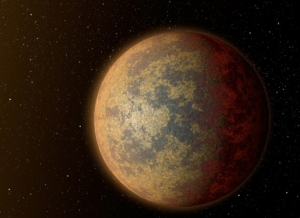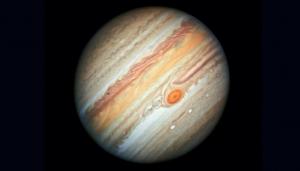LAB REPORT
Science and Technology Making Headlines
June 23, 2017


An artist’s impression of NASA’s probe reaching Psyche asteroid. An LLNL instrument on board will determine the elemental composition of Psyche's surface.
Lab instrument gets to the core of the matter
In a few years, an instrument designed and built by Lawrence Livermore researchers will be flying hundreds of millions of miles through space to explore a rare, largely metal asteroid.
The Livermore gamma ray spectrometer will be built in collaboration with researchers from the Johns Hopkins Applied Physics Laboratory for the first-ever visit to Psyche, the largest metal asteroid in the solar system.
Scientists believe the asteroid could actually be a planetary core that formed from a collision during the early stages of the development of our solar system.
"We believe that exploration of the Psyche asteroid could increase our understanding of the hidden cores of Earth, Mars, Mercury and Venus," said LLNL physicist Morgan Burks, who heads the Lab team.


Lawrence Livermore National Laboratory is one of the core national laboratories working on the DOE Exascale Computing Project.
That’s one big computer
Researchers behind the Department of Energy's Exascale Computing Project (ECP) are creating tools and technologies for exascale supercomputers — computing systems at least 50 times faster than those used today. These tools will advance researchers' ability to analyze and visualize complex phenomena such as cancer and nuclear reactors, which will accelerate scientific discovery and innovation.
Developing layers of software that support and connect hardware and applications is critical to making these next-generation systems a reality.
Researchers from Lawrence Livermore are collaborating with Argonne's Mathematics and Computer Science Division and four other core ECP national laboratories -- Lawrence Berkeley, Sandia, Oak Ridge and Los Alamos -- in addition to other labs and universities.
Their goal is to create new and adapt existing software technologies to operate at exascale by overcoming challenges found in several key areas, such as memory, power and computational resources.


Leiopathes (deep water black) coral is the oldest marine organism on Earth. Photo courtesy of NOAA Hawaiian Undersea Research Lab
Older than dirt
For scientists keeping tabs on the oldest living things in nature, figuring out the accurate age of an animal or plant has been a challenge. But that hasn’t stopped them from trying.
Lawrence Livermore scientists have dated one of the five oldest living things on Earth.
Coming in second is deep sea black coral. Researchers from LLNL, Stanford University and the University of California at Santa Cruz have determined that two groups of Hawaiian deep-sea corals are far older than previously recorded. According to Lawrence Livermore, the longest lived in both species, gold coral and black coral, was 2,740 years and 4,270 years, respectively, making them the oldest marine organisms.


HD 219134b is only 21 light years away, which makes it to date the nearest rocky super-Earth to our planet. It orbits around a star that is colder than our sun. Image courtesy of NASA/JPL-Caltech.
ET coming to a rocky planet near you
Large rocky planets, or super-Earths, could host alien life since they’re likely to develop powerful magnetic fields, according to a new study.
Super-Earths, which are up to 10 times more massive than Earth, may be able to harbor complex life, according to researchers from Lawrence Livermore National Laboratory. An LLNL study found that super-Earths could have powerful magnetic fields important for the development of an atmosphere, a mild climate and liquid water.
Magnetic fields protect planets from cosmic ray bombardment and solar wind. Powerful convection currents in our planet’s liquid-iron outer core generates Earth’s magnetic field. As the Earth spins, it generates a magneto-dynamo that produces the magnetosphere and is the source of most geological activity.
“Active plate tectonics and a magnetosphere are both considered requirements for a habitable exoplanet,” Rick Kraus, an LLNL physicist who was involved in the study. “A stable surface environment free of ionizing radiation is one of the most important qualities of a planet that are considered a requirement for habitability.”


Jupiter is not only the largest planet in our solar system, but it’s also the oldest, according to new research from Lawrence Livermore National Laboratory. Image courtesy of NASA
Happy birthday, Jupiter
Jupiter finally has a day to celebrate its birthday. As it turns out, Jupiter is the oldest planet in our solar system.
A new study from researchers at Lawrence Livermore National Lab and the University of Münster suggests that Jupiter may have begun forming within one million years of the very first inklings of the solar system. In the context of the 4.6 billion-year-old solar system, that makes Jupiter the oldest child.
The team lead by LLNL’s Thomas Kruijer studied the makeup of ancient meteorites from the outer solar system, which carry a signature of their birthplaces and are enriched in certain isotopes, or different masses of the same elements. Careful measurements of a meteorite's isotopes can point to its home.





